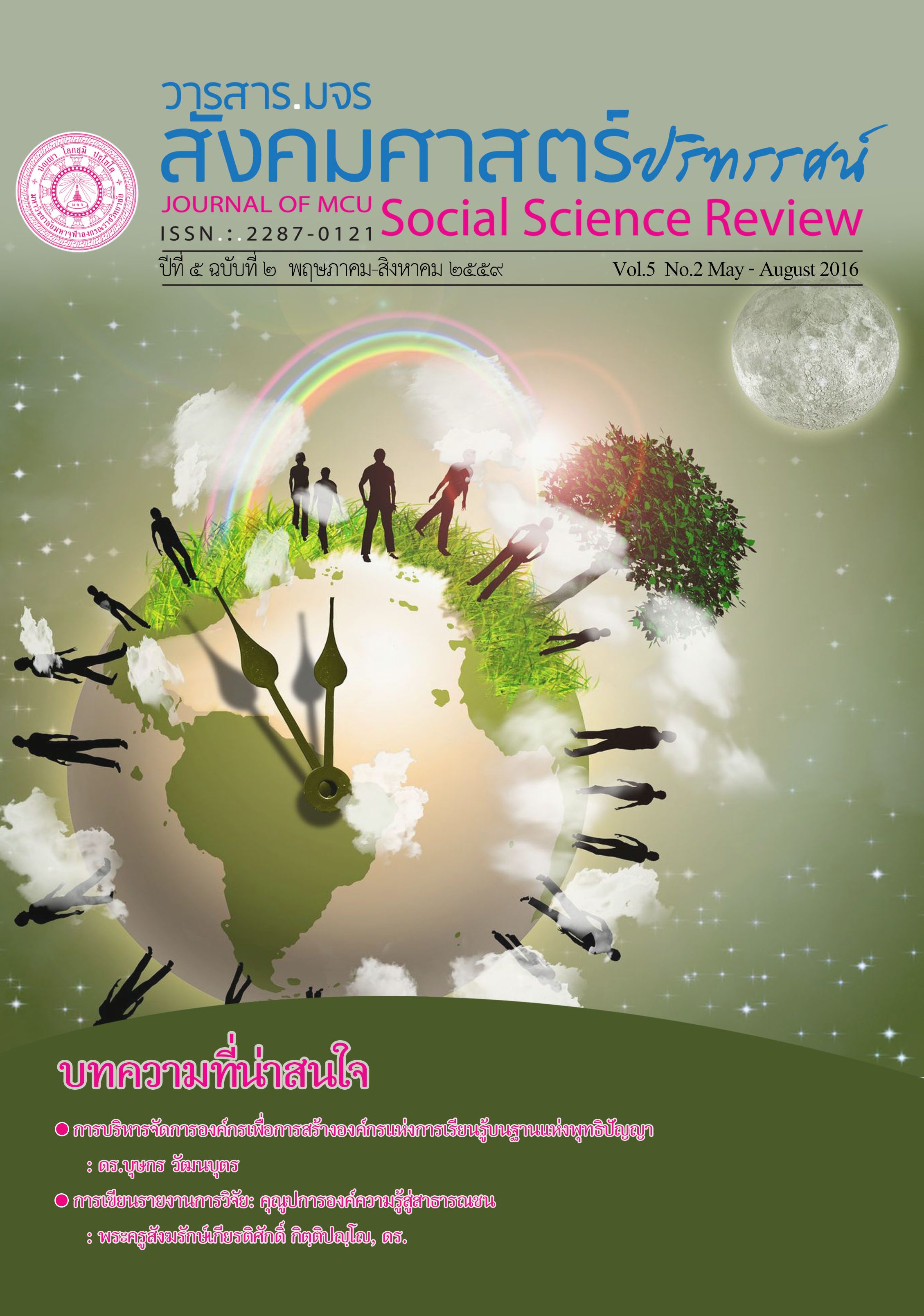พระอัจฉริยภาพของพระพุทธเจ้าด้านการแพทย์: ศึกษาจากเภสัชชขันธกะ
คำสำคัญ:
พระอัจฉริยภาพของพระพุทธเจ้า, การแพทย์, เภสัช, เภสัชชขันธกะบทคัดย่อ
เภสัชหขันธกะเป็นพระวินัยที่เกี่ยวข้องกับยรักษาโรคที่พระพุทธองค์ได้บัณญัติไว้ประกอบด้วย ๒๗ หัวข้อ บทความนี้ทำการศึกษาเพียง ๓ หัวข้อ เพื่อเป็นตัวอย่างแสดงให้เห็นพระอัจฉริยภาพของพระพุทธเจ้าต้านการแพทย์ คื ปัญจภสัชชกถา มูลาทิเภสัชซกถา และปิลินทวัจฉวัตถุ โดยทำการศึกษาเปรียบเทียบให้เห็นสรรพคุณของยาชนิดต่างๆ ที่พระพุทธองค์ทรงกำหนดไว้ว่าสอดคล้องกับสรรพคุณของสมไพรไทยอย่างไร จกการศึกษาพบว่า ๑) พระพุทธองค์ทรงมีพระอัจฉริยภาพในต้านการใช้ยาและการรักษา ยาส่วนมากเป็นสมุนไพรที่หาได้ง่าย และเป็นทั้งอาหารและยกี่ชาวบ้านทั่วไปในท้องถิ่นแถบโลกตะวันออกใช้บริโภคเพื่อบำรุงรักษาสุขภาพมาเป็นเวลาช้านาน แม้ในปัจจุบันย้มีใช้อยู่ทั่วไป ๒) พระพุทธองค์ทรงเอาใจใส่ต่อพระสาวกในด้านสุขภาพและความเป็นอยู่ ขณะเดียวกันพระพุทธองคำไม่ละเลยความสำคัญในบทบาทหน้าที่ของสงฆ์และการเป็นแบบอย่างที่ให้กับคฤหสในเรื่องการประพฤติปฏิบัติถูกต้องตีงมในการเก็บรักษายา และการใช้อุปกรณ์ต่างๆ เกี่ยวกับย การรักษาที่เหมาะสม รวมถึงการรับประเคนยาในเวลาที่ถูกต้องเหมาะสม๓) แม้ว่าพระพุทธองค์จะทรงสั่งสอนสาวกทั้หลายให้เห็นถึงสัจธรรมของชีวิตว่า จะต้องพบกับความแก่ ความเจ็ และความตายอย่างหลีกเยงไได้ แต่เมื่อคราวภิกษุอพาธก็มิใช่ว่าพระพุทธองค์จะทรงใช้ธรมโอสถเพียงอย่างเดียว พระพุทธองค์ยังคงอนุญาตให้ใช้ยาที่มีอยู่ในขณะนั้นมารักษาโรคภัยไข้เจ็บต่างๆ เพื่อบรรเทาความเจ็บป่วยด้วย กล่าวได้ว่า นอกจากพระพุทธองค์จะทรงสั่งสอนให้คนเป็นคนดี มีจิตใจที่ดีแล้ว พระพุทธองค์ยังให้ความสำคัญกับการรักษาสุขภาพ นั่นคือกายกับใจต้องไปด้วยก้ หกคามีปีญหา ใจก็มีปัญหาตามไปด้วย ดังนั้น ภิกษุจึงต้องดูแลหรือรักษาสุขภาพโดยคำนึถึงทั้งสองส่วนให้สมดุลกัน ทั้หมดนี้ จึงแสดงให้เห็นถึงพระอจฉริยภาพด้านการแพทย์ของพระพุทธองค์ได้อย่างชัดเจน
เอกสารอ้างอิง
วิทยาลัย เล่มที่ ๔ กรุงเทพมหานคร: โรงพิมพ์มหาจุฬาลงกรณราชวิทยาลัย, ๒๕๓๙.
มหาวิทยาลัยมหาจุฬาลงกรณราชวิทยาลัย. พระไตรปฎกภาษาไทยฉบับมหาจุฬาลงกรณราช
วิทยาลัย เล่มที่ ๕ กรุงเทพมหานคร: โรงพิมพ์มหาจุฬาลงกรณราชวิทยาลัย, ๒๕๓๙.
กองวิจัยและพัฒนาสมุนไพร กรมวิทยศาสตร์การแพทย์ กระทรวงสาธารณสุข; ดรุณ เพ็หรพลาย
จารีย์ บันสิทธิ์ ณฉัตรา จันทร์สุวานิชย์ ประถม ทองศรักษ์ และ ชาตรี ชาญประเสริฐ
(เรียบเรียง). สมุนไพรพื้นบ้านฉบับรวม. ม.ป.ท., ๒๕๓ต.
ภาควิชาเภสัชพฤกษศาสตร์ คณะเภสัชศาสตร์ มหาวิทยาลัยมหิตล; พร้อมจิต ศรลัมพ์ วงศ์สถิตย์
ถั่วกุล และ สมภพ ประธานรุรารักษ์. (บรรณาธิการ). สารานุกรมสมุนไพรเล่ม ๑
สมุนไพรสวนสิรีรุกขชาติ. พิมพ์ครั้งที่ 6. กรุงเทพมหานคร: อมรินทร์พริ้นติ้งแอนด์พับ
ลิซซิ่ง, ๒๕๔๘.
พระพรหมคุณาภรณ์ (ป.อ. ปยุตโต). การแพทย์ยุคใหม่ในพุทธทัศน์. พิมพ์ครั้งที่ ๗.
กรุงเทพมหานคร : สหธรรมมิก, ๒๕๕๔..
พร้อมจิต ศรลัมพ์ รุงะวี เต็มศิริฤกษ์กุลม วงศ์สถิตย์ ถั่วกุล และ อาทร ริ้วไพบูลย์ (บรรณาธิการ).
สมุนไพรและยาที่ควรรู้. พิมพ์ครั้งที่ ด. กรุงเทพมหานคร: อาร์ ดี พี, ๒๕๓๒.
พเยาว์ เหมือนวงษญาติ สมุนไพรก้าวใหม่ : แก้ไขปรับปรุงใหม่จากตำราวิทยาศาสตร์สมุนไพร.
พิมพ์ครั้งที่ ๒. กรุงเทพมหานคร : ที.พี.พริ้นท์, ๒e๓e.
รุงระวี เต็มศิริฤกษ์กุล พร้อมจิต ศรลัมพ์ วงศ์สถิตย์ ถั่วกุล วิชิต เปานิล สมภพ ประธานรุรารักษ์
และ นพมาศ สุนทรจริญนนท์ (บรรณาธิการ). สมุนไพร: ยาไทยที่ควรรู้ พิมพ์ครั้งพิเศษ
เนื่องในงานพระราชทานเพลิงศพ นายวัฒนา ชานนท์ เป็นกรณีพิเศษ.
กรุงเทพมหานคร: ศักติโสภาการพิมพ์, ๒๕๕๕.
สุภาภรณ์ ปิติพร. สมุนไพรอภัยภูเบศรสืบสานภูมิปัญญาไทย. พิมพ์ครั้งที่ ๓. กรุงเทพมหานคร :
ปรมัตถการพิมพ์, ๒๕๕๗.
ดาวน์โหลด
เผยแพร่แล้ว
รูปแบบการอ้างอิง
ฉบับ
ประเภทบทความ
สัญญาอนุญาต
ลิขสิทธิ์ (c) 2016 วารสาร มจร สังคมศาสตร์ปริทรรศน์

อนุญาตภายใต้เงื่อนไข Creative Commons Attribution-NonCommercial-NoDerivatives 4.0 International License.
เพื่อให้เป็นไปตามกฎหมายลิขสิทธิ์ ผู้นิพนธ์ทุกท่านต้องลงลายมือชื่อในแบบฟอร์มใบมอบลิขสิทธิ์บทความให้แก่วารสารฯ พร้อมกับบทความต้นฉบับที่ได้แก้ไขครั้งสุดท้าย นอกจากนี้ ผู้นิพนธ์ทุกท่านต้องยืนยันว่าบทความต้นฉบับที่ส่งมาตีพิมพ์นั้น ได้ส่งมาตีพิมพ์เฉพาะในวารสาร มจร สังคมศาสตร์ปริทรรศน์ เพียงแห่งเดียวเท่านั้น หากมีการใช้ภาพหรือตารางหรือเนื้อหาอื่นๆ ของผู้นิพนธ์อื่นที่ปรากฏในสิ่งตีพิมพ์อื่นมาแล้ว ผู้นิพนธ์ต้องขออนุญาตเจ้าของลิขสิทธิ์ก่อน พร้อมทั้งแสดงหนังสือที่ได้รับการยินยอมต่อบรรณาธิการ ก่อนที่บทความจะได้รับการตีพิมพ์ หากไม่เป็นไปตามข้อกำหนดเบื้องต้น ทางวารสารจะถอดบทความของท่านออกโดยไม่มีข้อยกเว้นใดๆ ทั้งสิ้น





